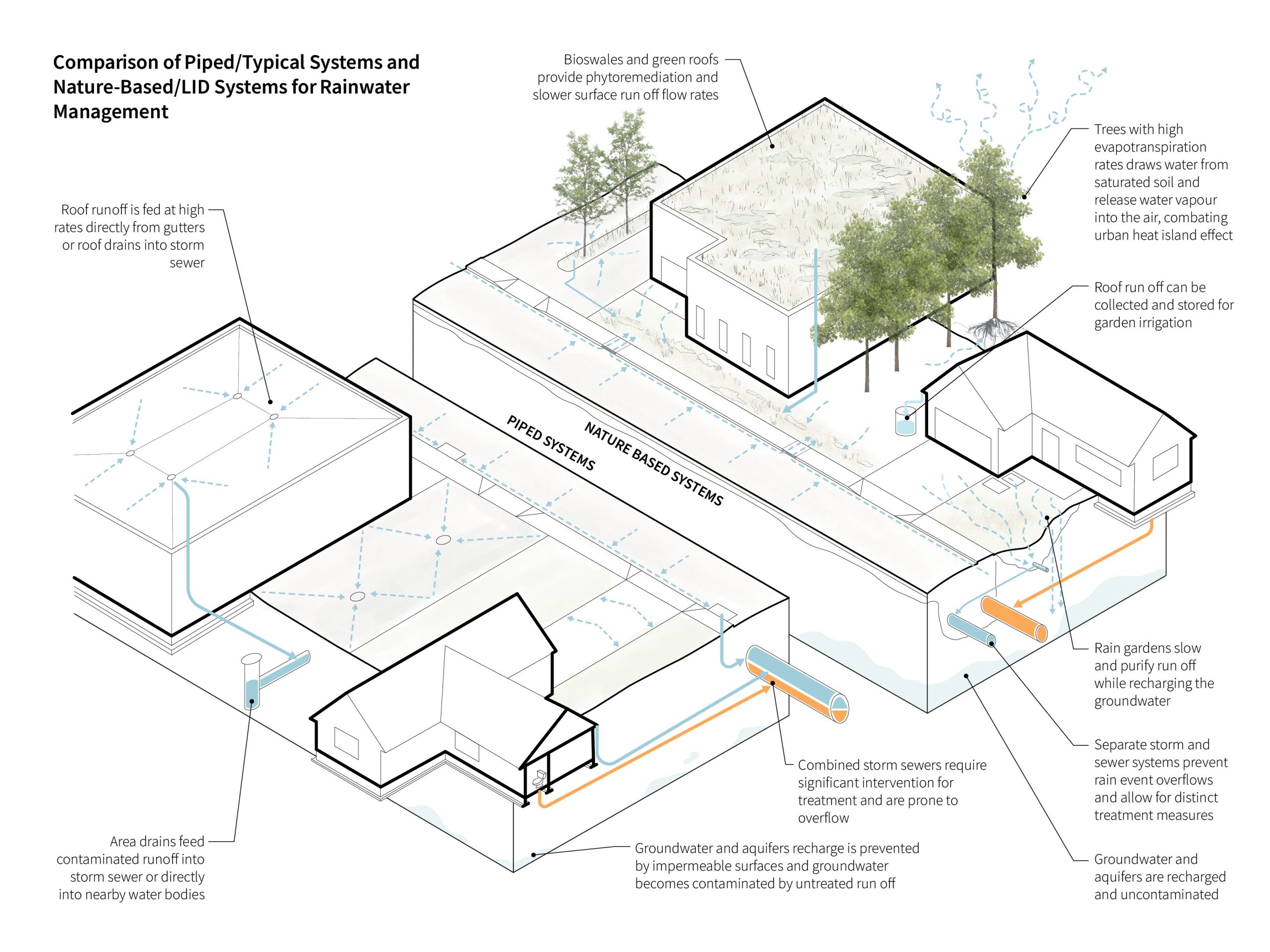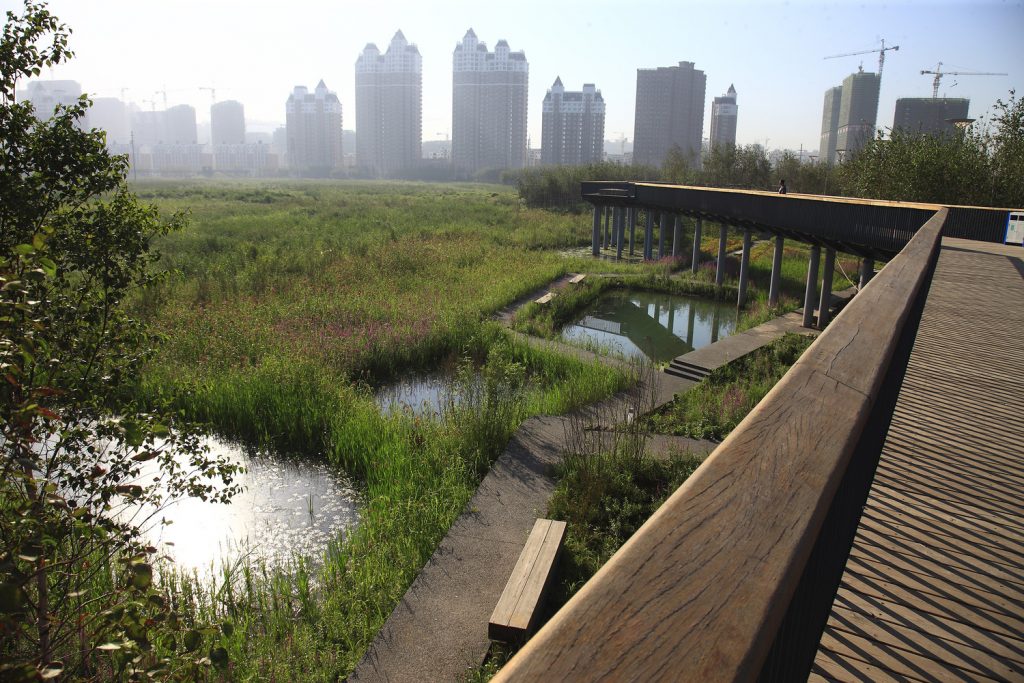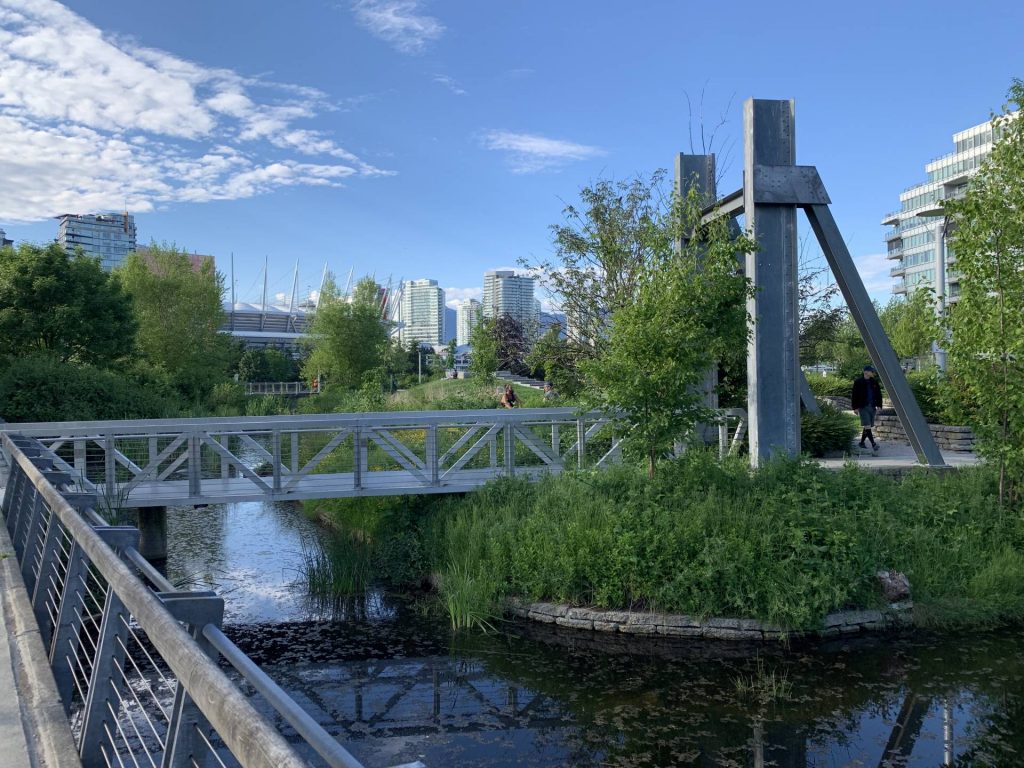Management of runoff during rain events has become one of the most critical – if overlooked – aspects of urban infrastructure. Since Roman times, we have been “plumbing” our urban watersheds: piping runoff and pulling it away from streets and buildings as quickly as possible. Over the last century, our urban centers have grown larger and more impermeable, while rain events have increased in their extremity as a result of climate change, exposing glaring faults in our urban rainwater management systems. It is imperative that designers of urban spaces understand the state of existing water infrastructure, design across scales for resilience in the face of change, and champion new ways of relating to rainwater in urban contexts.
What are some historical approaches to rainwater management?
The watershed is nature’s rainwater management system. Complex systems of geographical and biological forces shape and are shaped by flow of water, from raindrop to ocean. Natural watersheds are dynamic – constantly changing in response to variations. Their dynamic structure makes natural watersheds highly resilient in the face of climate change. Click here to dig deeper into the topic of watersheds.
Everywhere on earth bears a relationship to a natural watershed, including our most urbanized cities. However, urbanization has almost always resulted in alteration and often degradation of natural watersheds through the implementation of engineered infrastructure for rainwater management, “disregarding the local environment and the natural limits of each place”1. For example, A small, meandering creek might be replaced by a straight underground culvert or pipe, fed by surface drains. In this way, the creek is viewed as providing a single, replaceable service, and its physical and biological characteristics are overlooked.
As a result, the majority of urban stormwater infrastructure is underground, out of public view, focused exclusively on getting excess water out of the city and into nearby lakes, rivers, and oceans. Above ground, cities are often characterized by hard, impermeable surfaces such as roads, plazas, sidewalks, and roofs. Water runs off these surfaces into drains, which lead to pipes that carry the water away.
These systems have three overarching impacts on the natural health of urban areas: reduced biodiversity, depleted ground water/aquifers, and system overflow.
Reduced biodiversity: the presence of moving and still water is directly correlated with enhanced biodiversity (citation needed). Surface creeks and streams are critical areas of habitat for fish especially. For example, urbanization along the west coast of North America can be directly tied to the depletion of the salmon fishery over the last century due to the piping of spawning streams. Click here to learn more about riparian habitats.
Depleted ground water/aquifers: Natural watersheds have the ability to replenish ground water through permeable surfaces and standing water. Impermeable urban areas and extensive piping of runoff prevent this natural recharging of groundwater and aquifers, many of which we rely on for our own drinking water2.
System overflows: Many urban stormwater management systems are called combined sewers, which means that both sewer water and runoff are transported in the same system of underground pipes, all to be purified at water treatment facilities. These treatment facilities have a maximum capacity and are prone to being overwhelmed during significant rainfall events. In most cities, the result is combined untreated sewage and runoff overflowing into oceans and rivers through sewer outfalls, causing massive contamination3.
When engaging a project, it is critical to understand the paths that runoff has taken on its way to and from your site through history – whether through creeks or pipes – and the paths that it takes today.
1. Cahill, Low Impact Development and Sustainable Stormwater Management.
2. Pukhtoon, “Urban Development and Its Impact on the Depletion of Groundwater Aquifers…”
3. US EPA, “Combined Sewer Overflows (CSOs).”
What are some resilient options for rainwater management?
In the face of failing infrastructure and changing climate, environmental designers are at the forefront of developing a resilient future, regardless of project scale.
In the creek-to-pipe example above, the physical and biological characteristics of the creek were ignored in favor of its function of getting water from A to B. Many landscape architects and civil engineers have been returning to the physical and biological side of watersheds in search for solutions to our failing urban infrastructure, launching a field of research and design called Low Impact Development (LID).
LID (also occasionally referred to as Green Infrastructure or “GI”1) focusses on nature-based rainwater management systems, with emphasis on multi-benefit interventions and at-grade infrastructure, rather than single-purpose, below grade solutions. The principals of LID have been exercised across scales and are becoming more and more common in urban centers as a novel way of managing runoff. While LID is best viewed as a holistic, mass-scale approach, variations in the scale of interventions make it a helpful tool for understanding the impact a single project can have on the city as a whole.

Smaller scale interventions, such as rain gardens, bioswales, and green roofs, focus on slowing and filtering runoff. This helps reduce the load on drains and combined storm sewer systems during heavy rain events; one of the critical principals for LID is managing rainwater right where it falls2. It is important to note that these small interventions are not simply technological and solution-focused, but rather are multi-benefit, enriching the ecology and multisensorial experience of a landscape at human scale3.
Medium scale interventions are often focused on capturing rainwater for future use or recharging groundwater and aquifers. Examples at this scale include rainwater storage vaults, permanent retention ponds, permeable surfacing, and infiltration areas.
Large scale interventions aim at retrofitting urban infrastructure. For example, separation of sewer and storm water systems, large scale phytoremediation, reuse of rainwater in plumbing services (see also Water and Architecture), and daylighting streams.
Take a look at the following table for further examples of LID-based interventions across scales.
1. “Terminology of Low Impact Development.”
2. Cahill, Low Impact Development and Sustainable Stormwater Management.
3. Dunnet and Clayden, Rain Gardens.
How can Environmental Designers cultivate a new relationship with rainwater?
As LID-based projects bring water back into the public eye, there are new opportunities to build a more positive relationship with rainwater in urban centers. Beyond providing better function, daylighting our rainwater management infrastructure can reconnect a city and its inhabitants to the reality of where water goes, the history of the local watershed, and the biodiversity urban spaces are capable of supporting. Renewed presence of water encourages innovation and conversation, leading to novel ways of incorporating rainwater into daily public and private life. Designers of urban environments have a responsibility to engage and educate the public on these issues, both through design and engagement
Sources
Cahill, Thomas H. Low Impact Development and Sustainable Stormwater Management. John Wiley & Sons, Ltd, 2012. https://doi.org/10.1002/9781118202456.app1.
Dunnet, Nigel, and Andy Clayden. Rain Gardens: Managing Water Sustainably in the Garden and Designed Landscape. Portland, Oregon: Timber Press, 2007. https://www.academia.edu/download/61941210/0881928267_Rain_Gardens_Managing_Water_Sustainably_in_the_Garden_and_Designed_Landscape20200130-128986-bfi20g.pdf.
Pukhtoon, Yar. “Urban Development and Its Impact on the Depletion of Groundwater Aquifers in Mardan City, Pakistan.” Groundwater for Sustainable Development 11 (October 2020). https://doi.org/10.1016/j.gsd.2020.100426.
“Terminology of Low Impact Development: Distinguishing LID from Other Techniques That Address Community Growth Issues.” United States Environmental Protection Agency, 2012. https://www.epa.gov/sites/default/files/2015-09/documents/bbfs2terms.pdf.
US EPA. “Combined Sewer Overflows (CSOs).” Overviews and Factsheets. National Pollutant Discharge Elimination System, October 13, 2015. https://www.epa.gov/npdes/combined-sewer-overflows-csos.
Additional Resources
Cahill, Thomas H. Low Impact Development and Sustainable Stormwater Management. John Wiley & Sons, Ltd, 2012. https://doi.org/10.1002/9781118202456.app1.
An extensive and detailed textbook resource helpful for gaining further knowledge on LID strategies and principles.
Dunnet, Nigel, and Andy Clayden. Rain Gardens: Managing Water Sustainably in the Garden and Designed Landscape. Portland, Oregon: Timber Press, 2007. https://www.academia.edu/download/61941210/0881928267_Rain_Gardens_Managing_Water_Sustainably_in_the_Garden_and_Designed_Landscape20200130-128986-bfi20g.pdf.
A useful companion when designing all scales of rain gardens. This book includes the basic science of rain garden infrastructure along with precedents and strategies helpful for environmental designers.
Lim, H. S., and X. X. Lu. “Sustainable Urban Stormwater Management in the Tropics: An Evaluation of Singapore’s ABC Waters Program.” Journal of Hydrology 538 (July 1, 2016): 842–62. https://doi.org/10.1016/j.jhydrol.2016.04.063.
This resource provides a glimpse at strategies used for rainwater management in tropical countries, as well as an evaluation of an extensive policy program.
“Rain City Strategy: A Green Rainwater Infrastructure and Rainwater Management Initiative.” City of Vancouver, 2019. https://vancouver.ca/files/cov/rain-city-strategy.pdf.
This is the City of Vancouver’s overarching strategy to incorporate nature-based systems in new development and the existing urban fabric. Rain City Strategy is a helpful example of water-based public policy made accessible for both environmental designers and the general public.
Roehr, Daniel and Fassman-Beck, Elizabeth. Living Roofs in Integrated Urban Water Systems. London: Routledge, 2015. https://doi.org/10.4324/9781315726472.
A crossover resource also on the Water and Architecture blog, illustrating the role that green roofs play in larger urban landscapes.
Greenskins Lab. “Holistic Stormwater Management Application.” 2019. https://onedrive.live.com/?authkey=%21AGviy%5FdQiRBQQbQ&cid=E11813022BBE528C&id=E11813022BBE528C%218872
A helpful spreadsheet-based tool developed by Greenskins lab to visualize the calculations required for LID methods.
Precedents
Qunli Stormwater Wetland Park: Turenscape
Location: Haerbin, China

A 34 hectare park that collects, filters, and infiltrates stormwater from the surrounding urban fabric, while providing wildlife habitat and recreational access opportunities.
Project can be viewed here.
Hinge Park and South East False Creek: PWL Partnership, collaborators
Vancouver, BC, Canada

Completed for the Vancouver 2010 Olympics, this neighbourhood was designed “as a natural watershed that collects rainwater and uses natural methods to retain and filer runoff prior to discharge into False Creek.”
The Project can be viewed here.
